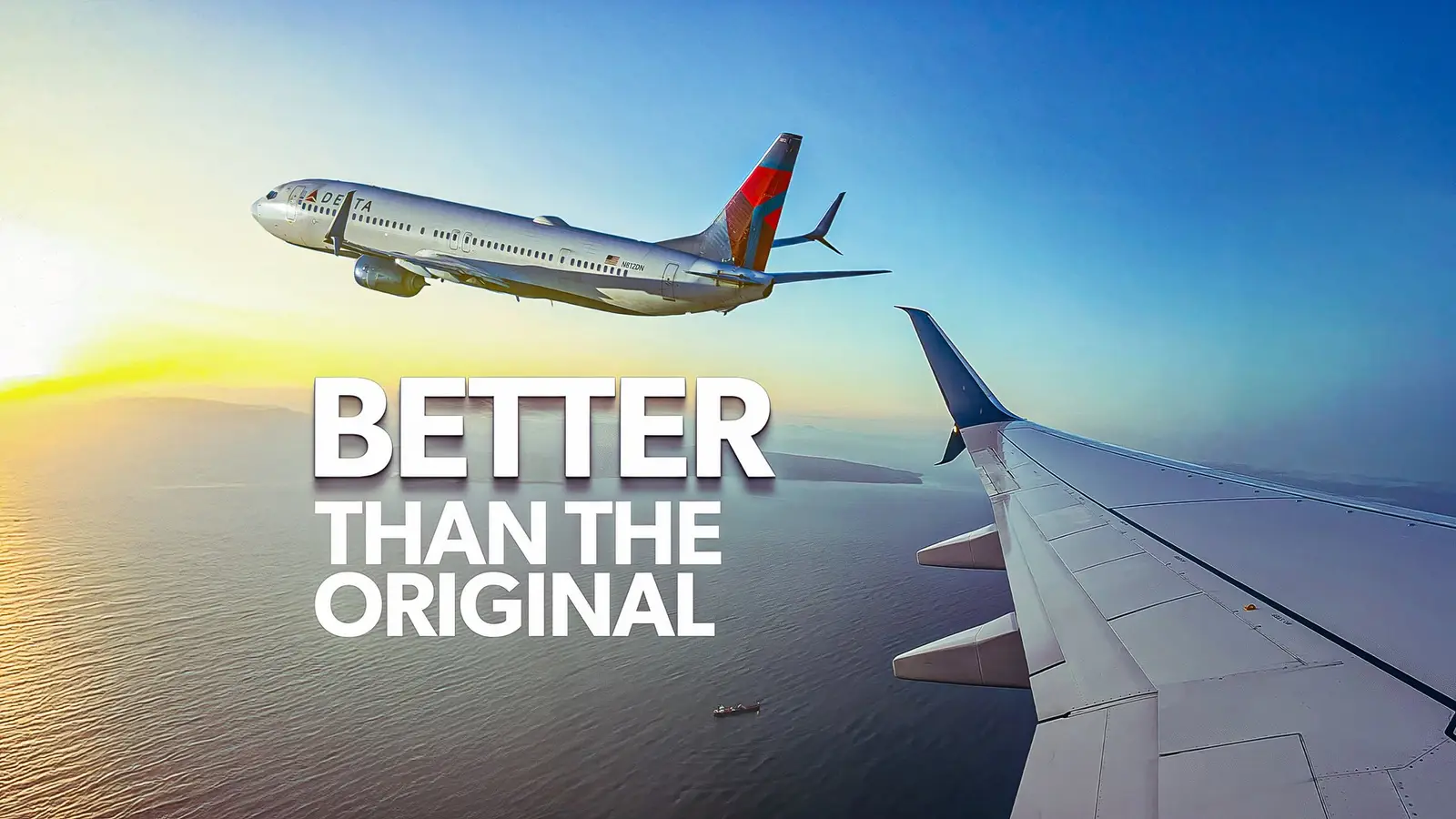
The Boeing 737 was designed before winglets became prevalent throughout the aviation industry. As such, 737s were delivered without winglets for most of the 20th century until the 737 NG series. Even then, early 737 NGs were originally delivered without winglets, and some were never retrofitted either. Beginning in 1997, however, Boeing began to offer winglets on the executive version of the 737 NG, and it soon became standard on the commercial variants.
Aviation Partners formed a joint venture with Boeing (APB) to offer its blended winglet design on the 737NG and later developed similar designs for the Boeing 757 and 767. The split-scimitar winglet, Aviation Partners’ next evolution in blended winglet design, was certified in 2014 for the Boeing 737-800, and later rolled out to the rest of the 737 NG. However, this design is far less common. Here’s why Delta Air Lines, one of the most prominent 737 operators, is rolling out this design across its fleet.
The APB Split Scimitar Winglet Retrofit
Aviation Partners was founded in 1991 and initially focused on increasing the range of business jets. The company developed a blended winglet design and installed it on a Gulfstream, yielding a superior fuel burn of roughly four to five percent. The joint venture with Boeing first covered the Boeing Business Jet while being optional on the 737 NG (except for the 737-600). The high demand for winglets soon led Boeing to make blended winglets standard.
The split scimitar winglet was developed by replacing the aluminum top of the winglet with a new, aerodynamically shaped cap and by adding a new ventral strake extending downwards. The new design saves even more fuel compared to the 737’s original blended winglet design, allowing for a slightly longer range or an increase in payload. Furthermore, split scimitar winglets also slightly improve low-speed handling.
While blended winglets have long been standard on the 737 NG, split scimitar winglets were only available as optional or as a retrofit. Split scimitar winglets are also only available on the 737 NG, as the Boeing 737 MAX currently in production features an entirely new split-tip design dubbed ‘Advanced Technology.’ Split scimitars were installed on many US-registered 737s, but were less common elsewhere in the world.
An Overview Of Delta’s Boeing 737 Fleet
Delta, the world’s third-largest carrier, currently operates a fleet of 240 Boeing 737s according to Planespotters.net. While this is substantial, Delta is also far from the largest operator of this legendary aircraft. In the US, American Airlines flies nearly 400 Boeing 737s, while United owns and operates well over 500 737s. Southwest Airlines, meanwhile, operates over 800 737s. Delta instead focuses more heavily on Airbus A320 family aircraft, of which it flies 314 examples.
Delta is the world’s largest operator of the Boeing 737-900ER, with 163 units. 33 of these were purchased second-hand from Lion Air after travel began recovering from the COVID-19 pandemic, as Delta aimed to quickly restore lost capacity from retired airliners, while 130 were delivered new to the carrier. Delta also flies 77 Boeing 737-800s, which are significantly older than the 737-900ERs, as most of these were delivered in the late 1990s and early 2000s.
Delta took delivery of its final Boeing 737-900ERs with split-scimitars and subsequently began retrofitting the rest of its fleet. In 2024, Delta announced that, along with an interior upgrade, it would begin retrofitting its 77-strong 737-800 fleet with split-scimitar winglets as well. These aircraft are progressively being retrofitted, and, although a timeline has not yet been provided as to when this will be completed, it shouldn’t be long until all Delta 737-800s feature split-scimitars.
The Benefits & Drawbacks Of Split Scimitars
Fuel cost is one of the biggest costs for an airline, and these companies go to great lengths to reduce fuel burn whenever possible. This is why almost every 737 NG flying today features either the blended winglet or the split-scimitar. Furthermore, Delta’s 737-900ER fleet flies a significant amount of longer domestic flights within the carrier’s network, and as such, was prioritized for split-scimitars. The 737-800, which tends to operate shorter segments, is only just receiving split-scimitars now.
By prioritizing the 737-900ERs, Delta saved significant sums on fuel across its network. The installation of these winglets on the 737-800, meanwhile, signals the Atlanta-based carrier’s commitment to the type. Despite the fleet’s average age being over 24 years old, Delta is investing in lowering the aircraft’s fuel burn and is installing new cabins, though they will not receive the Boeing Sky Interior.
Beyond the cost of installing the split-scimitars, the major drawback of these winglets is weight. Retrofitting a 737 with split scimitars slightly increases the aircraft’s weight, resulting in a small or negligible fuel burn difference, depending on the flight duration. As previously mentioned, the 737-900ER operates longer routes on average than the 737-800, and as such was prioritized over the 737-800 fleet for split-scimitar retrofits.
How Does Delta Compare To Other US Airlines On This Front?
In the US, the largest operators of the Boeing 737 are Southwest, United, American, Delta, and Alaska Airlines. Additionally, Avelo Airlines and Sun Country Airlines both operate smaller fleets of 737s, while Allegiant Air has recently begun taking delivery of 737 MAX aircraft. Of the seven carriers flying the 737 NG, Southwest, United, Delta, Alaska, Avelo, and Sun Country all operate at least some 737s with split-scimitars. American Airlines is the notable exception.
The carrier operates 303 Boeing 737-800s (along with 79 737 MAX 8s), and while nearly a third of its fleet was delivered after split-scimitars were made available, not a single 737-800 features it. This doesn’t mean that American will never install these winglets. Still, the carrier has clearly elected against installing these for now, with the cost of installation and the weight gain likely to be contributing factors as these planes are shifted towards shorter routes.
On the other end of the spectrum, United Airlines has retrofitted its entire fleet of Boeing 737s with split scimitars. Southwest has retrofitted its 737-800 fleet with split-scimitars, but many of its 737-700s are still flying with the older blended winglets. Only a handful of Sun Country’s 737s feature split-scimitar winglets, while Avelo’s 737 fleet was entirely purchased second-hand, with some featuring blended winglets and some featuring split scimitars.
Comparison: Delta’s Boeing 757 Fleet
Delta is the world’s largest operator of the 757, and it flies both the Boeing 757-200 and the 757-300. Just as with the 737 and the 767, the 757 was originally developed without winglets, but many were later retrofitted with the APB blended winglet. Later, a new winglet design was developed as a retrofit. It features a new, wider design with the same aerodynamically shaped tip as on the split scimitar, but without the ventral strake. As such, they’re dubbed ‘scimitar’ winglets.
United Airlines and Icelandair were the two primary customers for the scimitar winglets, and it’s not a coincidence that these are the two carriers that push the 757s to their limits range-wise. Delta Air Lines, however, no longer flies the 757 to continental Europe or to South America, and has also skipped out on the scimitar winglets. Instead, it’s focusing on widebodies for long-haul services while transcontinental routes will eventually be handled by the Airbus A321neo.
Delta is increasingly assigning its 757s to short-haul or regional routes, and as such, scimitar winglets would provide practically no benefit. Some of Delta’s 757-200s don’t even feature blended winglets, as the cost to install them and the fuel penalty from the weight is greater than the fuel savings from the improved aerodynamics on the routes that these planes operate. These planes are simply not used like how United or Icelandair uses the 757.
The Bottom Line
Split scimitar winglets are most beneficial on longer flights, where an airline can maximize the fuel savings from the improved aerodynamics compared to standard blended winglets. While these haven’t been as popular worldwide, split scimitar winglets have become nearly ubiquitous in the United States. It’s American Airlines that remains the exception for now.



